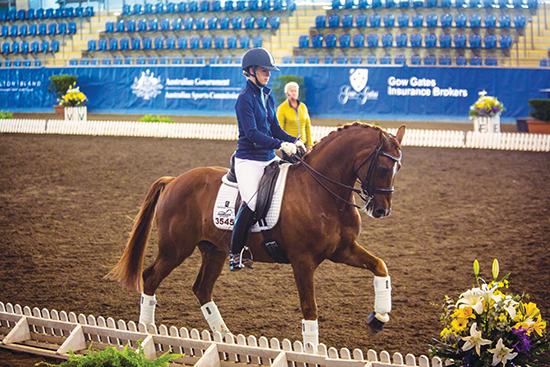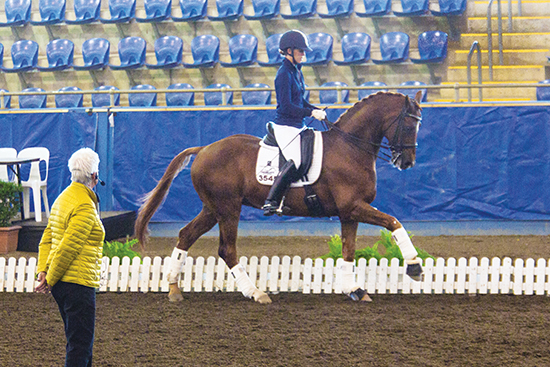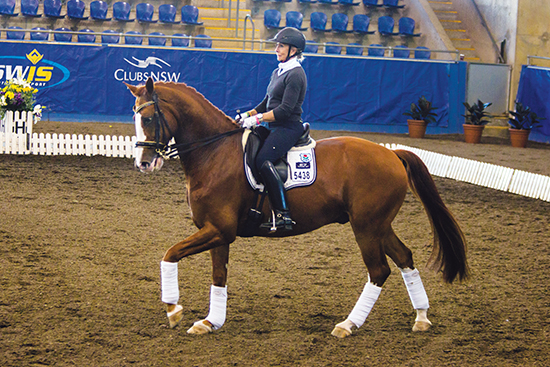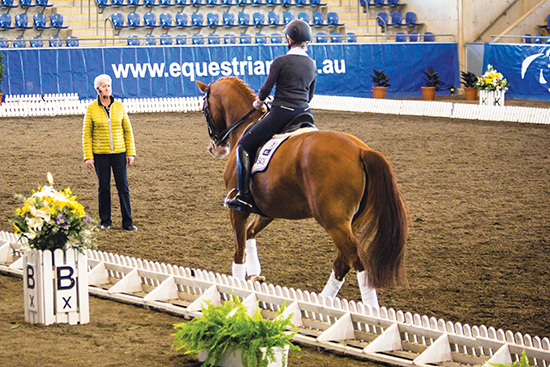Rebecca Ashton sits in on a clinic with Lilo Fore
 Robbie Soster and Robali Razzamatazz
Robbie Soster and Robali Razzamatazz
It was all about the flying changes for Robbie Soster and Robali Razzamatazz. The cute, little chestnut makes quite a big deal of them with his front legs. Lilo explained that the horse has to become more responsible for the work and isn’t to use his whole body to get the canter stride.
She spotted the problem in the walk, even before the pair began to canter, “He needs to bend all his joints, so he needs to swing through a little more. When you feel the artificial walk, and it is related to your canter, he is too low in front. Let him know it’s ok to look up a bit.”
Into the canter and Lilo commented that she thought Razzamatazz had a very young horse canter despite being a Grand Prix horse. “He needs to be more through. Don’t over push him. He needs to do the canter, not you.”
Lilo has a great tool kit and another exercise was devised to help improve the situation. “Canter right, walk transition, leg yield left to right, turn on the forehand to the left.”
She was focusing on the correct aids, quickness and the timing of the rider, “Hold with your seat but a smaller seat aid then have him a little quicker off your leg. Half halt on the outside rein then release. Don’t stop the horse cantering, just let it come easier.
“The changes shouldn’t be slower. Hold your seat and let it go up-and-down rather than rocking back-and-forward. Don’t hold with your leg, just ask him, and leave him alone. Don’t be greedy. Don’t stand because then you rock. Sit or else I’ll take your stirrups away! Make sure you ride the horse in the change. Ride him over the top line. He wants to be correct.”
Things were improving, but there was still more to be done to stop the hesitation mid-change. “He is like a climbing, levading horse. The repetition of the hindleg is not quick enough. I don’t want him to feel like he has to use his neck to throw himself forward.”
“Let your seat settle, and go towards your hands. We don’t correct the changes, we are changing his behaviour in the canter. Don’t come back into the contact when he lands. Half halt is not climbing. Don’t pull; just ride them.”
“Follow without giving the canter away. Stay with your hips a little more. He has to keep the separation of the hindleg, but he doesn’t have to climb. Your long reins make him come behind the vertical, short reins keep him in front of the vertical.”
It was time to try two tempis and both rider and trainer had to be inventive to outwit the gelding. Lilo offered, “Medium canter, collected canter, medium, collected and then the two times changes. I think he’s very clever, so you have to have a few games and make life a little interesting for him.”
A break in the walk meant a stretch for the horse, but not the rider who still needed to ride correctly, “Now walk…look you’re holding again. I want YOU to walk.”
Back to the canter and another interesting exercise from Lilo, “Now move him away from the rail and back to the rail, and away and back, just a little, just so he jumps away from the leg a little so he knows your legs are to be listened to. When you collect, it mustn’t slow down. Keep the tempo. Now we just have to make him realise he can do it in the one tempis. You have to come back in the up-beat, not in the down-beat. The half halt happens when they are in the air. It’s a timing thing. You have to truly work on that, then the changes will be beautiful. When he lands, you should be thinking forward, or else you pull them behind in the landing. Let your legs just hang and touch. Collect without shortening his frame. At the moment it is like he pops the cork out every stride. He pushes it out with the front legs. Pow! But he’s as cute as a button.”
Adjustability in canter and good suppleness led to a more polished performance and there will no doubt be some super one tempis coming from this combination in the near future.
Judy Dierks and Diamond Star practise the small squares
It was planned that Judy Dierks and Diamond Star would ride their freestyle through but after such a massive weekend including a win in the Kür the night before, it was decided to keep it simple and quiet for the tired combination who have only just begun their Grand Prix journey together.
Pirouettes are a bit of an issue for the pair so it was decided to work on these, but not before a couple of corrections to Judy’s position, “Keep your left shoulder down and right leg down. Don’t pull back your right inside shoulder. Think of your outside hip being back. I’m not going to let you go around crooked. Everything on your right falls down. You have to stay straight. In the corners, you don’t turn, the horse turns. Your inside hip in the canter should be leading. The horse should come to your seat rather than you pushing your seat down and pushing the horse away. You want to think your shoulders and heels are horizontal to the ground. Now, ride haunches in, but just the horse’s haunches. Don’t you turn!”
Lilo then focused on quality and correctness of the canter and was again clever with her exercises. Although the pirouette was being trained, it wasn’t even attempted until after a series of exercises to improve the canter.
“Training horses is all about suppleness, throughness, impulsion, and making sure they can perform in balance. Things are trained with skill and careful preparation. You should feel that the horse, even in the smallest circle is forward and not behind you. The moment the rider feels that he has to ride the horse forward, it means it is behind you. So, Judy don’t have so much contact. He jumped on both hindlegs at the same time in the tests yesterday, so you have to train the horse in its suppleness and forwardness. Think shoulder fore in the corner but don’t bend the neck.”
Correct, deep and balanced corners were addressed first which smoothly led on to small half circles. “Ride down the long side, turn in the corner, ride down quarter line then a small five metre half circle into the corner. You have to make sure that the repetition of the hindleg is like a little bunny. That quickness has to stay a little with you in the collection. THAT is your basic work that you have to do to make the pirouettes.”
Judy gave it a go and Lilo helped to finesse it, “You were too focused on riding a pirouette and all I wanted was a small five metre half circle. Make the canter shorter in the next corner. Keep yourself vertical. We have to not forget about focusing on ourselves, not just the horse all the time.”
“Collect him in the corner, but don’t stop him. Never feel that he is squatting. That is what you see in Europe, corners being ridden. They are the easiest training tool you can have.
“At the highest degree of collection you want to feel the horse is in front of you. You have to lift yourself to lift your horse. I don’t mean to be stiff, but more from the core.”
“What I noticed yesterday in general was that the horses are so bent in the necks that the uphill vertical balance is lost. Ask yourself, ‘Can I see the horse’s poll in front of the neck? Can I feel the horse’s haunches behind?’ They are the engine. The inside leg keeps the inside leg forward and upward thinking.”
Judy and Diamond Star
This segued into the next exercise, a small square in the corner. Lilo forewarned all of us, “If you think that’s easy, you’re mistaken. Don’t make a circle turn, make a corner, a straight line and turn. Canter to the bit, then turn. Canter the hindleg forward then turn the shoulder.”
It worked a treat and soon the pair were doing beautiful work in the pirouette without the movement having even been mentioned. “You cannot put a nail into the wall with a screwdriver. You have to find the right tool,” explained Fore. It was no different for the trot. Correct, deep corners helped to set up the half pass.
Lilo corrected the first attempt, “You ride too much with your outside leg thinking of the sideways. Shoulders lead onto the diagonal and then inner leg. Keep the shoulder moving up hill. Beautiful.”
Before the end, Judy executed some lengthened trots down the long side. Lilo again had some advice, “He sunk. The front leg swings out but the shoulders go down. Sit vertical and don’t put your body backwards. Not faster, that is wrong. Don’t chase him and then hold on for dear life. You and the horse go forward at the same time. Keep your seat sitting square not your rear end tucked under. I don’t want to see flying front legs. I want to see the forward moving through the whole body.”
And guess what? It worked. Although Lilo may have set tongues wagging when sitting in the judge’s box over the course of the CDI, when it came to running an informative and helpful clinic, Ms Fore was the real deal.





